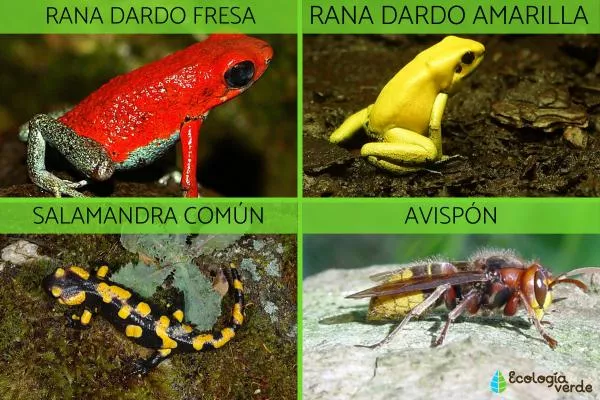
Have you ever wondered why poison frogs are brightly colored? It is one more survival strategy that exists within the amazing world of living beings. Specifically, we are talking about aposematism. Thanks to scientific studies linked to the natural selection of species, today we know the main characteristics of aposematism, as well as why this surprising ability developed by many species throughout their biological evolution is due.
If you want to discover what aposematic or warning coloration is, to better understand how aposematic species adapt and survive in the planet's ecosystems, continue reading this interesting article by Green Ecologist about what is aposematism and examples of this.
What is aposematism
Aposematism is the phenomenon or strategy used by different species of animals (and some plants), to warn other species of living things of their chemical toxicity. Coming from the Greek "apo" (far, apart) and "sema" (signal), aposematism is based on using warning signs to ward off other species, mainly predators. To do this, aposematic species have striking colorations and certain behaviors that they use as a warning sign of their own toxicity.
Now that we know what the warning colors on animals and plants or the aposematism strategy, let's go on to see in the next sections more characteristics and concrete examples of this amazing phenomenon of nature.
Aposematism: characteristics
Among the main characteristics of aposematism stand out:
- The kind of aposematic colorations that exist among living things that use this survival strategy. Generally, these aposematic colorations present intense yellow, orange, red, blue and black colors, sometimes combined with each other, or separately.
- When observing these colors in their prey, predators relate that it is a species with some type of toxic substance, poison, or irritating liquids that can cause injury and even death.
- In this way, aposematic species have different characteristics related to their aposematism, so that they can have glands that release irritating compounds, toxic substances on your skin, or even stingers that inject poison.
Examples of aposematism
Inside of the animal aposematismAmphibians and insects are the groups of organisms that have most developed this strategy of warning of its toxicity, although there are also some species of aposematic mammals and even aposematism strategies in fish. In the following list we offer examples of aposematism, mentioning common and scientific names of many of the aposematic animal species more incredible and, furthermore, below you can find their photos in the same order:
- Strawberry dart frogOophaga granulifera)
- Yellow dart frogPhyllobates terribilis)
- Common salamander (family Salamandridae)
- Hornet (Vespa crabro)
- Wasps (Order Hymenoptera)
- BeesApis mellifera)
- Mantis shrimp (Gonodactylus smithii)
- Skunks (family Mephitidae)
- Coral snake (family Elapidae)
- Lion fish (Pterois antennata)
- Ladybugs, San Antonio vaquitas or ladybugs (Coccinella septempunctata)
- Monarch butterfly (Danaus plexippus)
To learn more about this topic, we recommend this other article: Are salamanders poisonous?



Difference between crypsis, mimicry and aposematism
Among the strategies that many species of animals and plants have developed to survive, those related to hiding with the environment that surrounds them and even resembling other poisonous species to be confused by predators stand out. For each of these strategies, within biology different concepts are distinguished. Next, we talk about mimicry, crypsis and aposematism and their differences:
Mimicry
Mimicry involves the use of a specific anatomy and coloring by the body as a costume that imitates another species the one you want to be like in every way possible to ensure your survival. It is amazing how, without maintaining any kind of biological relationship or kinship, two different species manage to resemble each other morphologically, with the aim of achieving some biological advantage and guaranteeing their survival. Thus, through mimicry, organisms deceive other species with which they live in the same habitat (mainly their predators), confusing their senses of sight, hearing and smell and, in this way, they manage to survive longer. weather.
To learn more about this survival strategy, we encourage you to read this other article about What is mimicry and examples.
Crypsis or camouflage
Camouflage or crypsis is the individual's ability to blend in with the environment where it is. This is achieved by changing its color and / or its shape to have a camouflage that gives more effective results and that, in this way, predators cannot differentiate it.
If you want to know more about the crypsis or camouflage strategy, we recommend this post about 20 animals that camouflage themselves.
Aposematism
Finally, as we have seen throughout the article, aposematism simply allows toxic and / or poisonous species to warn of their danger to avoid being captured by most of their predators. In this way, aposemtaism could be considered as a anti-camouflage strategy, since the species expose their intense warning colorations to other living beings, instead of camouflaging themselves with the environment to avoid being discovered by their predators.
To continue expanding this information, do not hesitate to meet these Animals that change color and their strategies.
If you want to read more articles similar to Aposematism: what it is and examples, we recommend that you enter our Biology category.
Bibliography- Lanteri, A. & Del Río, M. G. (2014) Imitation in nature. Science Today Magazine (Spain).
- Recalde, J.I. & San Martín, A. F. (1995) Some "isms" related to the chemical defense of certain coleopterans: mimicry and aposematism. SEA Newsletter, Volume 12, pp: 13-15.
- Wolfgang. W. (1968) Mimicry in plants and animals. Library for modern man, pp: 15-47.


